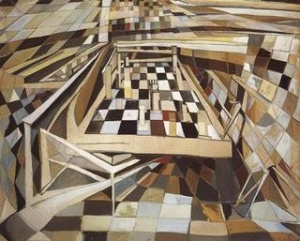Mate at a Glance
Home * Evaluation * King Safety * Mate at a Glance
Mate at a Glance,
an attempt to detect positions statically in evaluation, where one side (not necessarily the side to move) has a legal move to checkmate its opponent king. This is either a direct mate for the side to move or a mate threat, where one needs to defend accordantly rather than to stand pat at a quiescent node.
Mate at a Glance was introduced in 1978 by John Birmingham and Peter Kent at Advances in Computer Chess 2, as implemented in their Minimax algorithm Tester Master, and published 1980 in the conference proceedings [2]. Some mate pattern were implemented in various programs, as known for instance from Rebel [3], Chess System Tal [4], XiniX and IsiChess [5] . Some programmers apply Mate at a Glance only for cheap and simple cases which occur frequently, like obvious back rank mates, some close mates with the queen, and possibly mates with knight like the smothered mate. A few programmers apply more general, but also likely more complicated and error-prone pattern.
Contents
Is it worth?
Whether the effort and amount of code for Mate at a Glance is worth, is disputed, considering mate threats from null move pruning as well the inconsistency in knowing some mates but not others. However, programs with a sophisticated King Safety evaluation and appropriate data-structures like attack and defend maps may detect tactical motives like skewers and some mates "en passant", to either control the search with less strict conditions, or with a Bloom filter like approach, where false positives refer to no mate, to immediate return mate scores for true negatives.
Mate Pattern
Close Queen Mate
A queen can often mate close to the opponent king on straight (or less frequent diagonal) adjacent squares, most often in front of a king on the back rank. Following conditions may be applied conjunctively in an order from cheap to expensive.
- A set of all "mating squares" is determined by the intersection of queen attacks with all squares exclusively defended by the opponent king, but not occupied by pawns and pieces of the queen side.
- A "mate square" is attacked not only by one queen, but additionally by any other piece, even indirectly due to a battery
- The queen is not absolutely pinned on a direction other than its moving direction
- The "mate square" is not indirectly defended by a slider of the king side through the queen.
- The set of up to two possible escape squares is empty, even after playing the queen move.
- off the boards (in case of border king)
- occupied by pieces of the king side
- attacked by pieces from the queen side, but not exclusively by the queen itself, which no longer controls this square after moving.
Epaulette Mate
The Epaulette mate with the queen is a quite simple pattern to detect.
Mates with sliding Pieces
This also covers the typical back rank mates as well as the rare Boden's Mate. As preconditions to look further, a vulnerable king with only up to two escape squares (if any) exclusively on one line, either rank, file, diagonal or anti-diagonal, and an attacking sliding piece, which can safely move to that line. Further conditions necessary cover defenders blocking distant checks, including discovered defenses - and similar to the closer queen mates, whether the check giving piece decontrols a former taboo escape square of the king. Some programs even detect some mates in N statically, considering "worthless" delaying blocking moves.
See also
- Attack and Defend Maps
- Checkmate
- Checks and Pinned Pieces (Bitboards)
- Evaluation Patterns
- King Safety
- Mate Distance Pruning
- Mate Search
- Mate Threat Extensions
- Vulnerable on distant Checks from King Pattern in Bitboards
- X-ray Attacks (Bitboards)
Selected Publications
- John Birmingham, Peter Kent [6] (1980). Mate at a Glance. Advances in Computer Chess 2, reprinted in Computer Chess Compendium
Forum Posts
- Static Mate Detection by Gerd Isenberg, CCC, January 22, 2002
- Ptterns by Manuel Peña, Winboard Forum, November 20, 2008
- Algorithm for mate recognition by Fulvio, CCC, June 30, 2017
External Links
- Back-rank checkmate from Wikipedia
- Boden's Mate from Wikipedia
- Checkmate pattern from Wikipedia
- Smothered mate from Wikipedia
References
- ↑ Maria Helena Vieira da Silva - Carolus Chess
- ↑ John Birmingham, Peter Kent (1980). Mate at a Glance. Advances in Computer Chess 2, reprinted in Computer Chess Compendium
- ↑ Re: Static Mate Detection by Ed Schröder, CCC, January 23, 2002
- ↑ move count frequency by Chris Whittington, CCC, December, 08, 1997
- ↑ Static Mate Detection by Gerd Isenberg, CCC, January 22, 2002
- ↑ In the ICGA Database John Birmingham is mentioned as sole author
